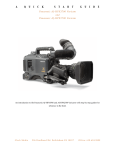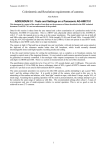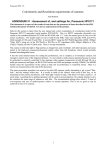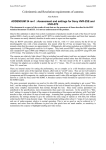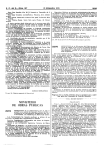Download ADDENDUM 36 : Menu settings for Panasonic P2 AJ-HPX3700
Transcript
Panasonic AJ-HPX 2300
December 2008
Colorimetric and Resolution requirements of cameras
Alan Roberts
ADDENDUM 36 : Menu settings for Panasonic P2 AJ-HPX3700
This document is a report of the results of tests that are the precursor of those described in the EBU
technical document Tech3335. It is not an endorsement of the product.
A brief assessment was made on a production sample of the AJ-HPX3700 (serial number K7TKA0112), a
HDTV camcorder with a Canon HA18x7.6 HD lens. It is very similar in form and function to the other
cameras in the HPX series, particularly the 3000 and 2700, sharing many features and having a very similar
menu set.
The camera has 3 full-resolution ccds, 1920x1080 active sensors (2010x1120 total) and operates only at
1080-line HDTV standards. It can be switched between interlace (50i, 59.94i) and progressive (25psf,
29.97psf, and 23.98psf in both 2:3 and 2:3:3:2 pull-down) modes. It has a variable frame-rate mode in which
it can record at frame rates from 1 per second up to the system frame rate. It can generate a “film look” in
the camera, and has specific “film-look” gamma curves that incorporate many of the contrast handling
features of earlier cameras, making it a great deal easier to set up. It is superficially identical to the
HPX3000 and HPX3700.
The recording system is either the conventional DVCProHD format (8-bits, 1440x1080, 6.7:1 compression at
29.97Hz, 6.3:1 at 25Hz) or the newer AVC-Intra at 100Mb/s (10-bits, full resolution, H.264, I-frame only) or
at 50Mb/s (¾ horizontal sample count, 4:2:0) onto solid-state P2 cards (5-cage slots in the camera).
Sensitivity is specified as F/10 at 2000lux, power consumption 38 watts, weight 4.9kg without lens or
viewfinder. Interestingly, it can output full-resolution images in 4:4:4 mode via dual HDSDI, but not record
them. This mode was not tested.
It is a little larger than the HDX900, being wider to accommodate the P2 cards instead of the tape
mechanism, and has HDSDI output. It has striking similarities to the HPX2100, 2700 and 3000 with which
it should be compatible. There is a side-panel lcd display for menu setting and access to recorded files. It
has many internal menus for setting the performance, such that it can then be used without external controls.
It is not ideally suited to multi-camera operation (being a camcorder) but has enough features to make multi
use possible. Monitoring and connectivity have been improved over previous Panasonic models; it will
genlock to either analogue HD Y or analogue composite (PAL or NTSC as appropriate); there are two video
outputs, one switchable between HDSDI, SDI (appropriate down-conversion), and composite (PAL or
NTSC), the other between HDSDI and HD analogue Y for monitoring. It has a LCD side-panel, useful for
menu setting etc.
The camera section has 14-bit ADCs that deliver better noise performance than in earlier models. There is
also an 8-second cache for pre-recording.
In this setup, the gamma correction and knee are adjusted to capture almost 2 stops of overload, and 1 stop of
underexposure, to mimic film performance.
The settings derived here are from a joint test session with the HPX3000 and 2700, where it was found that
the same settings could be used across the cameras, giving the same results. This means that the cameras can
be freely mixed in productions.
1
Panasonic AJ-HPX 2300
December 2008
Colorimetric and Resolution requirements of cameras
Alan Roberts
ADDENDUM 36 : Menu settings for Panasonic P2 AJ-HPX2300
Many menu items have little or no effect on the image. Those that do so are highlighted. The full menus are
given for completeness. Where three values are given {f} denotes film use, {v} video and {w} wildlife. The
film mode uses the “Filmlike1” gamma curve, which very closely resembles the best that can be done with a
conventional gamma curve and knee, but with a nice smooth join; there seems no point in ignoring this curve
since Panasonic have clearly put much effort into its design, and it works well. The photographic speed of
the camera is unchanged using this curve (“Filmlike2” is a similar curve but copes with about a stop less of
overload and reduces the photographic “speed” by about a stop, also the manual knee controls have no effect
in this mode so it is not possible to customise it; “Filmlike3” further reduces the exposure range and lowers
the photographic “speed” of the camera by about one stop more; both these modes should produce better
noise performance and thus may well be the best option for film-like work). The camera also has the “FilmRec” curve of the Varicam. The video mode uses conventional gamma and knee settings to achieve similar
results but with more contrast compression in highlights. Both modes can cope with about 1.7 stops of
overexposure (about 350% measured); the video mode (with optimal knee settings) has a slightly more
pronounced change of slope in the knee but the difference is marginal. The wildlife mode uses the Film-Rec
gamma. The exposure range is about 11 stops.
The shutter can be set to HALF (i.e. 180º), which avoids the problem of having to work out what it should be
from the field/frame rate.
Line Mix mode appears to be the equivalent of EVS in other cameras. Switched on in 25p mode, Line Mix
reduces the vertical resolution to the same as 50i, thus minimising most interlace twitter artefacts although
the effect is not great. There is an 8-second video cache for pre-recording.
When shooting at 59.94 field/29.97 frame rates, drop-frame time code is always used.
Viewfinder and monitoring outputs can both have markers, individually set.
The camera “Gain” switch stores many camera settings, allowing the user to set completely different
conditions selectable by that switch. However, most users will want only different gain, the menu contents
given here are appropriate for the range of gains quoted, it is for the user to decide which gain settings are
appropriate and to set the other conditions accordingly. Beware that the recommended settings were derived
during a short laboratory test of the camera; better settings may well be found once the camera goes into
general use. The settings given in each switch setting are those recommended for use at the gains given, the
user may select what gains to use, but noise precludes the use of higher gains.
DRS (Dynamic Range Stretching) appears to be a fully automatic knee and gamma control, untested here,
but could be useful when there’s no time to derive best settings.
The camera does not have an SD mode at all.
Factory settings are underlined. Clearly, the digital processing owes much to the design of the other HDX
cameras, the menu structure is very similar, and many of the settings for the other HDX cameras have the
same effect in this camera. Values are given for Video (v), Film look (f), and Wildlife (w). These settings
include rather more detail enhancement than usual, because the camera’s basic resolution is clean enough to
sustain it.
This should not be used as a substitute for reading the manual.
These settings were derived in a joint test session with the HPX3000 and 2700, where it was found that the
same settings could be used in each camera, with the same results. Very possibly, the same is true with the
HPX2100, but this has not yet been established.
2
This document is a report of the results of tests that are the precursor of those described in the EBU
technical document Tech3335. It is not an endorsement of the product.
Panasonic AJ-HPX 2300
1
December 2008
Menus and settings
SYSTEM SETTING
DVCPROHD/60i, AVC-I 100/60i, AVC-I
100/30PN, AVC-I 100/24PN, AVC-I 50/60i,
AVC-I 50/30PN, AVC-I 50/24PN
1080-23.94PsF,
24PsF
AVC-I 100/24PN, AVC-I 50/24PN
1080-50i
DVCPROHD/50i, AVC-I 100/50i, AVC-I
100/25PN, AVC-I 50i/50P, AVC-I 50/25PN
Camera Mode
VFR
24P VFR Rate
Frame Rate
USR SW F.Rate
Scan reverse
PC Mode Select
PC Mode
Codec selection and
recording/shooting
mode2
DVCPROHD/ 1080 60i, 59.94i
60i, 30P, 24P, 24PA
Sets pulldown mode, not
DVCPROHD/ 1080 50i
50i, 24P
needed in AVC-I.4
Otherwise
24P, 24P
Off, On
Variable Frame rate
24, 30
Max frame rate in 23.98 or 24fps
59.94i, 23.98PsF, 24PsF 1~24~60
Can also be set with the Synchro Shutter
controls
50i
1~25~50
59.94i, 23.98PsF, 24PsF 1~24~60
The frame rate that can be assigned to a User
Button
50i
1~25~50
On, Off
For lenses that invert the picture
For connection to USB hard-drive5:
USB host, USB dev
Host=camera control, Dev=PC control
On, Off
Enables remote (PC) control
Option mode
Item
Access LED
P.Off GPS Data
SDI Metadata
Save Switch (Aud out)
Save Switch (lcd)
Range
Off, Slot side, LCD side, Both
Hold, Clear
On, Off
Off, On
Off, On
Rec function
Item
Interval rec mode
Interval rec hold
Rec time
Pause time
Range
On, One shot, Off
On, Off
00s01f~59s29f
00h00m00s01f~00h04m59s29f
description
1080-50i
1080-59.94i
AVC-I 100/24PN3
Rec Format
Any change requires a power-off/on cycle to
take effect. Different defaults for E/P models1
1080-50i
1080-59.94i, 1080-23.98PsF,
1080-24/PsF, 1080-50i
System Mode
AVC-I 100/25PN
Range
AVC-I 100/50i
Item
1080-50i
Main video standard setting
BBC
description
v
f
w
System mode
25
24
General options
BBC
v
f
w
Enables the P2-card activity LED’s
Holds GPS data while power off
Embed UMID data into HDSDI
Disables audio out when in power “Save”
Disables LCD when in power “Save”
Specialist recording functions
BBC
description
v
f
w
Uses internal memory store
On keeps the settings through power Off
Frames to be grabbed, frame count goes up to
the frame rate-1
Time between grabs
________________________________________________________________________________________________
1
Panasonic’s nomenclature for formats does not accord with the EBU’s: Panasonic’s 1080-50i would be known by the
EBU as 1920x1080i/25, the number after the slash being the frame rate.
2
P=Progressive, i=Interlaced, PsF=Progressive with Segmented Frames, i.e. progressive carried via an interlaced
signal, PN=Progressive Native i.e. recording only new frames. Both I and PsF will record duplicated frames to fill the
time-line at the system frame rate if needed, PN won’t.
3
In theory, this should be the best for wildlife, because it can be set variable for frame rate up to 60fps. However, the
time-code and gen-lock inputs will be at 24fps, not a standard video speed. So this mode will be difficult to use with
external sound recording. If 60fps is not needed, then set to 1080-50P, which will genlock to 50Hz and time-code will
make sense.
4
24PA is actually 23.98Hz when the system speed is 59.94. PA is “advance pull-down”, 2:3:3:2
5
The camera can be used as a hard-drive source for the editor, to move clip files, controlled either from the camera or
the computer.
3
This document is a report of the results of tests that are the precursor of those described in the EBU
technical document Tech3335. It is not an endorsement of the product.
Panasonic AJ-HPX 2300
Total take time
Total rec time
Audio rec
Start delay
Pre Rec Mode
Pre Rec Time
Loop Rec Mode
December 2008
~23h59m59s29f
None~5day
None, 00m00s01f~99m59s29f,
Over100min
On, Off
0sec~10sec
On, Off
1s~8s
On, Off
Rec Start
All, Normal
P.On Rec Slot Sel
Hold, Slot 1
Output sel
Item
Range
Signal Format
4:2:2, 4:4:4
P-10Log
On, Off
Output Item
HD SDI A-B Char
Monitor Out
Monitor Gamma
VFR/LCD Char
VF Mode
VF Sel
Thumbnail Out
Downcon Mode
Menu Only, TC, Status
Off, A, B, Both
VBS, HDSDI
On, Off
VF-Off, LCD-Off, On
Mem, Cam
Mono, Color
On, Off
Lt-Box, Squeeze
HDSDI A-B Out Marker
Item
Marker Sw
Centre Mark
Safety Mark
Safety Area
Frame Mark
Frame Sig
User Box
User Box Width
User Box height
User Box H Pos
User Box V Pos
Range
Off, A, B, Both
Off, 1, 2, 3, 4
Off, 1, 2
80~90~100%
On, Off
4:3, 13:9, 14:9, Vista, Snsco
On, Off
1~13~100
1~13~100
-50~0~50
-50~0~50
Moni Out Marker
Item
Centre Mark
Safety Mark
Safety Area
Frame Mark
Frame Sig
User Box
User Box Width
User Box height
User Box H Pos
User Box V Pos
Range
Off, 1, 2, 3, 4
Off, 1, 2
80~90~100%
On, Off
4:3, 13:9, 14:9, Vista, Snsco
On, Off
1~13~100
1~13~100
-50~0~50
-50~0~50
None=continuous
Report, not control
Sound capture during interval recording
Delay to start interval grabs
8-second cache pre-recording
Length of video cache
All allows recording to start even during
playback except in Interval Rec mode
Which P2 slot to use on power-up
Signals on the displays
BBC
description
v
f
w
444 uses both HDSDI outputs.
Selects 10-bit log to replace Film Rec gamma,
for 444 output only6
Puts metadata onto video outputs
Superimpose characters on HDSDI feeds
Composite SD or HDSDI on the Monitor BNC
Correct for Film-Rec gamma on video out7
ON
Puts characters on LCD and viewfinder
Mem=EE, Cam always shows the camera
Puts thumbnails on monitor video outputs
Aspect ratio on SD monitor feed
What goes on the HDSDI feeds
description
BBC
All markers on HDSDI outputs
1=big, 2=big hollow, 3-small, 4=small hollow
1=box, 2=corners
Set outer box in %age
90
Vistavision=1.85, Scope=2.35
Settable box
Size in %age
14:9
Position in %age, from middle
What goes on the monitoring feed
description
BBC
1=big, 2=big hollow, 3-small, 4=small hollow
1=box, 2=corners
Set outer box in %age
Vistavision=1.85, Scope=2.35
Settable box
Size in %age
Position in %age, from middle
Simple controls
LCD monitor
________________________________________________________________________________________________
6
This should be a good way of capturing 444 output, similar to equivalents on other cameras intended to shoot in filmmode.
7
This is a very welcome addition. Film-Rec gamma is very good, but difficult to use. This correction is an
approximation to the curve-bending needed in post, and so should produce representative monitoring.
4
This document is a report of the results of tests that are the precursor of those described in the EBU
technical document Tech3335. It is not an endorsement of the product.
Panasonic AJ-HPX 2300
Item
Brightness
Color Level
Contrast
Backlight
Self Shoot
December 2008
Range
-7~0~+7
-7~0~+7
-7~0~+7
Normal, High
Normal, Mirror
description
BBC
description
Genlock source
Which output is locked8
Coarse H timing
Fine H timing
BBC
Genlock
Item
Genlock
GL.Phase
H.Phase Coarse
H.Phase Fine
Range
Int, Ext
HDSDI, Composit
-100~0~100
-100~0~100
PAINT MENUS
RB Gain Control
Item
R Gain AWB Pre
B Gain AWB Pre
R Gain AWB A
B Gain AWB A
R Gain AWB B
B Gain AWB B
AWB A Gain Offset
AWB B Gain Offset
Range
-200~0~200
-200~0~200
-200~0~200
-200~0~200
-200~0~200
-200~0~200
On, Off
On, Off
description
Red gain in switch Preset balance
Blue gain in switch Preset balance
Red gain in switch A balance
Red gain in switch A balance
Red gain in switch B balance
Red gain in switch B balance
On adds A values above after rebalance in A
On adds B values above after rebalance in B
Range
-200~0~200
-100~0~100
-100~0~100
-100~0~100
On, Off
-100~0~100
-100~0~100
-100~0~100
description
Master black level
Red ped, reports value from remote control
Green
Blue
On enables these values
Red flare correction
Green
Blue
RGB Black Control
Item
Master Ped
R Pedestal
G Pedestal
B Pedestal
Pedestal Offset
R Flare
G Flare
B Flare
Range
A, B
-63~31~63
-63~-4~63
-63~-1~63
-63~4~63
-63~1~63
-63~-1~63
Off, A, B
Off, A, B
Off, A, B
Color Correction
Item
R (Sat/Phase)
R-Mg (Sat/Phase)
Mg (Sat/Phase)
Mg-B (Sat/Phase)
Range
-63~0~63
-63~0~63
-63~0~63
-63~0~63
More colour balancing
BBC
0
Colour matrix, user settings
description
BBC
Two user tweakable matrices
Settings for matrix A or B9
31
-8
-1
4
1
-1
Select matrix in Low
A
Mid
A
High gain setting
A
Matrix (User preset) A,B
Item
Matrix Table
Matrix R-G
Matrix R-B
Matrix G-R
Matrix G-B
Matrix B-R
Matrix B-G
L Matrix Table
M Matrix Table
H Matrix Table
Colour balancing
BBC
rather dangerous territory
description
BBC
Adjusts colour in 45 degree segments, tweaks
saturation and hue.
This is rather dangerous, but can be very useful
________________________________________________________________________________________________
8
The monitoring output, when set to SD, has about 90-line delay relative to HD output. This control determines which
output is actually locked to the genlock source.
9
These matrix settings are the same as for the HPX3000 and HPX3700. They make slight improvements to the
appearance of a Macbeth test chart. Very possibly, they would improve the HPX2100 as well.
5
This document is a report of the results of tests that are the precursor of those described in the EBU
technical document Tech3335. It is not an endorsement of the product.
Panasonic AJ-HPX 2300
B (Sat/Phase)
B-Cy (Sat/Phase)
Cy (Sat/Phase)
Cy-G (Sat/Phase)
G (Sat/Phase)
G-Yl (Sat/Phase)
Yl (Sat/Phase)
Yl-R (Sat/Phase)
Color Correct
December 2008
-63~0~63
-63~0~63
-63~0~63
-63~0~63
-63~0~63
-63~0~63
-63~0~63
-63~0~63
Off, On
for special effects. Generally, you should avoid
this unless you have good test kit, including
comprehensive colour test charts.
+63/+6010
On
Low Level Gain switch position
BBC
description
v
f
w
dB settings, 3dB steps
-3
-3
-3
11
10
8
6
15
12
8
4
31
Low luma zone, no correction
1
0.01 steps
0.45
No other controls
Off
1=20%, 2=30%, 3=40%
User preset matrices
A
12 segment adjust, see above
On
Low Setting
Item
Master Gain
H Dtl Level
V Dtl Level
Dtl Coring
H Dtl Freq
Level Dep
Gamma
Black Gamma
Black Gamma Range
Matrix Table
Color Corr.
Range
-3, 0~30dB
0~10~63
0~15~31
0~4~60
0~18~31
0~1~5
0.30~0.45~0.75
-8~Off~+8
1, 2, 3
A, B, Off
On, Off
Mid Level Gain switch position
BBC
description
v
f
w
dB settings, 3dB steps
0
0
0
8
6
5
12
8
6
8
31
Low luma zone, no correction
1
0.01 steps
0.45
Off
1=20%, 2=30%, 3=40%
User preset matrices
A
12 segment adjust, see above
On
Mid Setting
Item
Master Gain
H Dtl Lev
V Dtl Lev
Dtl Coring
H Dtl Freq
Level Dep
Gamma
Black Gamma
Black Gamma Range
Matrix Table
Color Correct
Range
-3~3~30dB
0~8~63
0~12~63
0~12~60
0~18~31
0,1~5
0.30~0.45~0.75
-8~Off~+8
1, 2, 3
A, B, Off
On, Off
High Level Gain switch position
BBC
description
v
f
w
dB settings, 3dB steps
6
6
6
6
5
4
8
7
6
12
31
Low-luma zone, no correction
1
0.01 steps
0.45
Off
1=20%, 2=30%, 3=40%
User preset matrices
A
12 segment adjust, see above
On
High Setting
Item
Master Gain
H Dtl Lev
V Dtl Lev
Dtl Coring
H Dtl Freq
Level Dep
Gamma
Black Str
Black Gamma Range
Matrix Table
Color Correct
Range
-3~6~30dB
0~6~63
0~10~63
0~12~60
0~18~31
0~3~5
0.30~0.45~0.75
-8~Off~+8
1, 2, 3
A, B, Off
On, Off
Additional Dtl
Item
Range
description
Detail, extra controls
BBC
________________________________________________________________________________________________
10
Yellow was rather green and de-saturated. This setting makes some improvement but still doesn’t get it right. The
user should decide whether to use it or not.
11
The factory settings for detail are a little high, but don’t do much damage. I prefer these lower values.
6
This document is a report of the results of tests that are the precursor of those described in the EBU
technical document Tech3335. It is not an endorsement of the product.
Panasonic AJ-HPX 2300
Knee Ape Lvl
Dtl Gain +
Dtl Gain Dtl Clip
Dtl Source
Master Dtl
December 2008
Off, 1~5
-31~0~31
-31~0~31
0~63
(R+G)/2,(G+B)/2, (2G+R+B)/4,
(3G+R)/4, R, G
-31~0~31
Correction in knee compressed zone
correction, +ve going edges
correction, -ve going edges
Clip level of detail correction
Doesn’t make much difference except when
noise level is high
Copy of master control
Off12
0
0
0
description
Select skin tone table, reduces wrinkles
Zebra on skin tone detector
Adds skin tone zebra to HDSDI
BBC
Off
0
Skin Tone Dtl
Range
Off, A, B, AB
On, Off
On, Off
On, Off
On, Off
A, B
0~16~31
0~190~255
0~10~255
0~35~255
0~55~255
0~10~90
-180~0~179
Range
Master Ped
Manual Knee
Knee Point
Knee Slope
White Clip
White Clip Lvl
A Knee Point
A Knee Level
A Knee Response
Chroma level
-200~0~200
On, Off
70%~93~107%
0~85~99
On, Off
90%~109%
80%~93~107%
100~107~109
1~4~8
Off,-99%~0%~40%
DRS effect depth
1, 2, 3
Hi-Color Sw
Hi-Color Level
On, Off
1~32
Don’t use Auto knee, manual is better
BBC
description
v
f
w
Duplicate entry for pedestal
0
Valid only if AUTO is off
On
Manual break point
85
Gain in knee zone, about 2.5 stops overload
99
50
50
On
109%13
Auto knee point
85%
105
Auto knee response speed (low=fast)
4
Saturation control14
0
Dynamic Range Stretch, auto-tweaks gamma and
1
knee
15
Expands colour dynamic range
Off
Dynamic colour expansion range
Differentials and colour tweaking
BBC
description
v
f
w
0.45
Set R away from Master
0
Set B away from Master
0
Gamma
Item
Master Gamma
R Gamma
B Gamma
Gamma Mode Sel
Range
0.30~0.45~0.75
-15~0~15
-15~0~15
HD, SD, Filmlike1,
Filmlike2, Filmlike3,
FilmRec, Video Rec
HD=709, SD=BBC0.4, approximately. Film-Rec
is Varicam Film Rec16
HD
Film
-Rec
Cam Main Menu 1, Knee Level
Item
And on the monitor output
Separate tables of target tones
Looks for skin tone
Sharp/Soft detail
Max luma level for skin
Min luma level for skin
Saturation mean level for skin
Saturation range for skin
Hue mean level for skin
Hue range for skin
Film
like1
Item
Skin Tone Dtl
Zebra VF
Zebra HD SDI A
Zebra HD SDI B
Zebra Moni
Detect Table
Skin Tone Get
Skin Dtl Effect
Y Max
Y Min
I Center
I Width
Q Width
Q Phase
________________________________________________________________________________________________
12
This was not specifically tested, as its relevance depends on the type of scene. Use it if there is needed detail in any
part of the scene above the knee point or above 100%.
13
Video signals will go above 100%. Make sure that the post-production operation knows this and can deal with it.
14
Use this as a saturation control, rather than tinkering in the Color Correction.
15
Control over saturation in the upper part of the luma range, around the knee.
16
For Filmlike 3, Panasonic recommend using manual knee (Point=85%, Slope=50), Filmlike1 and 2 effectively builtin knee . The gamma curves can be ordered by the video level from an 18% reflectance chart, HD, Filmlike1, Filmlike2,
Filmlike3, Video-Rec, Film-Rec. When using Film-Rec, the Monitor Gamma function should be used (see Output Sel
menu).
7
This document is a report of the results of tests that are the precursor of those described in the EBU
technical document Tech3335. It is not an endorsement of the product.
Panasonic AJ-HPX 2300
F-Rec Dynamic Lvl
F-rec Black Str Lvl
V-Rec Knee Slope
V-Rec Knee Point
December 2008
200%, 300%, 400%, 500%,
600%
0~30%
150~500%
30%~107%
17
Exposure range in Film-Rec
Black Stretch specific to Film-Rec
18
Knee point specific to Video-Rec
Camera Settings
Item
Range
description
Detail
Gamma
Test Saw
Flare
H-F Compe
On, Off
On, Off
On, Off
On, Off
On, Off
All detail
VF Display
Item
Status Mode
Range
Normal, Film-Rec
Disp Condition
Normal, Hold
Disp Mode
VF Out
VF Dtl
VF Dtl Coring
VF H.Dtl Freq
Zebra 1 detect
Zebra 2 detect
Zebra 2
Low Light Lvl
RC menu Disp
Marker/Char Lvl
Synchro scan disp
1,2,3
Y,NAM,R,G,B
0~5~10
0~15
1~4~6
0%~70~109%
0~85~109%
Off, Spot, On
Off, 10%~35%
On, Off
50%~100%
Sec, Deg
Wide-band aperture correction
Range
A, B
Off, 1~4
Off, 1, 2
80%~90~100%
On, Off
4:3, 13:9, 14:9, Vista, Cnsco
0~15
Set for skin tone (BL-TR)
Set for white (TL-BR)
SPOT works only if Zebra 2>1
Warns at low light level
Shows menus in v/f when RC is connected
Marker/Character brightness
Seconds or degrees, only for synchro shutter
description
Switch between AB, 2 sets of setups set below
Cross size/type
1=box, 2=corners
Size of safety area
Frame marker
Vistavision is 1.85, Cinemascope=2.35
Picture level outside frame mark, 15=same
Range
On, Off
1~13~100
1~13~100
-50~0~50
-50~0~50
Off
75
65
100%
Spot
35%
65
Viewfinder stuff
BBC
14:9
0=centred
VF Indicator 1
Item
Extender
Shutter
Filter
White
Gain
w
Off
More viewfinder stuff
description
BBC
Custom frame
Width, %
VF User Box
Item
User Box
User Box Width
User Box Height
User Box H Pos
User Box V Pos
BBC
f
On
On
User controls (RC=remote control)
BBC
description
v
f
w
Film-Rec disables much of what follows
Show switch status:
Normal
Normal=On, Hold when ModeCheck pressed
1=off, 2=some, 3=all
What you see, NAM=non-additive mix
Y
10 roughly doubles the HD detail in the v/f
Avoids enhancing noise
VF Marker
Item
Table
Centre Mark
Safety Mark
Safety Area
Frame Mark
Frame Sig
Frame Lvl
v
On
Range
On, Off
On, Off
On, Off
On, Off
On, Off
description
Lens extender
Shutter speed display
Filter position
Show AWB or Preset A/B
And yet more
BBC
On
On
________________________________________________________________________________________________
17
This controls the exposure range of the camera. Set 600% in very high contrast scenes, 200% for low-contrast scenes.
18
Use this control when shooting in Video Redc. 150% for low contrast scenes, 500% for high contrast, to taste.
8
This document is a report of the results of tests that are the precursor of those described in the EBU
technical document Tech3335. It is not an endorsement of the product.
Panasonic AJ-HPX 2300
Iris
Camera ID
ID Position
Date/Time
Zoom Lvl
Color Temp
System Mode
Rec Format
Frame Rate
December 2008
Off, Iris
Off, Bar
UpperR, UpperL, LowerR, LowerL
On, Off
On, Off
On, Off
On, Off
On, Off
On, Off
Iris (aperture/auto) display
Show camera ID over bars
Placement
Show time/date with camera ID
Focal length
Camera system speed
Selects Dynamic Range Stretcher display
VF Indicator 2
Item
CAC
Gamma Mode
DRS
P-10Log
VF Gamma
Monitor Gamma
Range
On, Off
On, Off
On, Off
On, Off
On, Off
On, Off
description
Astigmatism correction19
Log law for 44 dual HDSDI output
Gamma compensation for Film Rec mode
VF Indicator 3
Item
P2 Card Remain
Battery
Audio Level
TC on color bar
TC
System Info
Range
Off, One Card, Total
On, Off
On, Off
On, Off
Off, TCG, TCR, TCG/TCR
Off, Always, Normal
Save LED
Save, P2 Card
Rec Status
Proxy Rec
On, Off
On, Off
description
How much is left
Voltage
Bar-graph meters
On
On
What happens when you press Mode Check
description
BBC
Get the status screen
On
Shows why !LED might be lit
On
Function screen
On
Audio screen
On
Lens tweaks
Range
On, Off
On, Off
On, Off
On, Off
On, Off
On, Off
On,Off
Get status screen up at power-on
! LED
Item
Gain (0dB)
Shutter
White Preset
Extender
Black Gamma
Matrix
Color Correct
Filter
Even more
BBC
The usual timecode stuff
Normal=3 second display of problems
Save warns when in Save mode, P2 warns when
card nearly full
Rec indicator in VF
Proxy recording to P2 and/or SD card
Mode Check Ind
Item
Status
!LED
Function
Audio
CAC
User Sw Status
P.On Ind
And still more
BBC
Range
On, Off
On, Off
On, Off
On, Off
On, Off
On, Off
On, Off
On, Off
description
Range
description
Max 10 characters
On
VF warnings
BBC
OPERATION
Camera ID
Item
ID1
ID2
ID3
3 lines of text
BBC
________________________________________________________________________________________________
19
Astigmatism correction for lenses that have the software to talk to the camera.
9
This document is a report of the results of tests that are the precursor of those described in the EBU
technical document Tech3335. It is not an endorsement of the product.
Panasonic AJ-HPX 2300
December 2008
Shutter Speed
Item
Syncrho Scan
Synchro Scan 2
Position 1
Position 2
Position 3
Position 4
Position 5
Position 6
Range
On, Off
On, Off
On, Off
On, Off
On, Off
On, Off
On, Off
On, Off
Select which speeds go onto the switch list
description
BBC
Speed set by buttons near filter wheel, longest
exposure depends on frame rate
ON adds items to list of settings that can be cycled
through using the switch below the lens.
Shutter Select
Item
Position 1
Position 2
Position 3
Position 4
Position 5
Position 6
Range
[59.94] 1/60, 1/100, 1/120, 1/250, 1/500, 1/1000,
1/2000, HALF, 180d, 172.8d, 144d, 120d, 90d, 45d
[50] 1/50, 1/60, 1/100, 1/120, 1/250, 1/500, 1/100,
1/2000, HALF, 180d, 172.8d, 144d, 120d, 90d, 45d
Factory
180d
172.8d
144d
120d
90d
45d
User SW
Item
User Main Sw
User 1 Sw
Range
Factory
User 2 Sw
Inh, I.Over, S.Blk, B.Gamma, Yget, DRS, Assist,
C.Temp, VFR, FRate, VF Gam, Audio Ch1, AudioCh2,
RecSw, RetSW, Pre.Rec, SlotSel, PCmode
Marker Sel
(User 3 Sw )
Text memo
(User 4 Sw)
Inh, Y get, Assist, VF Gam, VF Mark, Rec Sw, Ret Sw,
Pre Rec, Slot Sel, PC Mode
Inh, Y get, Assist, VF Gam, VF Mark, Rec Sw, Ret Sw,
Pre Rec, Slot Sel, PC Mode, Text Memo
description
HALF keeps
exposure at 180º
irrespective of field
or frame rate.
Assign user switches
BBC
description
v
f
w
VFR20
Y Get
VF
Gam22
VF
Mark
Text
Memo
SW Mode
Item
Ret Sw
S.Blk Lvl
Auto Knee Sw
Shd,Abb Sw Ctl
Color Bars
Range
R.Review, Cam Ret
Off, -10, -20, -30
On, Off, DRS
On, Off
description
Review last few seconds/check Genlock input
Super black level, not a good idea
Disables Auto Knee switch
Does black shading with black balance if pressed
>8secondfs
SMPTE, Full Bars, Split
RC Check Sw
R.Review, Play
Side Sw lock
Off, On
Range
Filter Inh
On, Off
Shockless AWB
AWB Area
Temp Pre Sel Sw
Color Temp Pre SW
AWB A Temp
AWB B Temp
Off, Fast, Normal, Slow1,
Slow2, Slow3
25%, 50%, 90%
Var, 3.2k/5.6k
2300K~3200K~9900K
2300K~3200K~9900K
2300K~3200K~9900K
Y Get21
More general stuff
BBC
R.Review
Off
On
SMPTE
What haopopens when you press Record on the
remote control
On disables Gain/Output/AWB switches
White Balance Mode
Item
BBC
1/60
1/120
1/250
1/500
1/1000
HALF
description
Off allows separate balance data to be stored for
each filter wheel position
Presets
BBC
On
Response speed to white change, 1~20 seconds
Central screen target area
Fixes auto white to either 3.2 or 5.6k, good idea
AWB set in Preset
AWB set in A, reports result of rebalance
AWB set in B, reports result of rebalance
3200K
3200K
3200K
Lens/Iris
________________________________________________________________________________________________
20
This is the easiest way to shoot off speed, so is a must for wildlife shooting.
21
And this is a wonderfully useful light meter, giving the luma level at the centre marker.
22
VF Gam is essential when shooting with Film Rec gamma, so is a must for wildlife shooting.
10
This document is a report of the results of tests that are the precursor of those described in the EBU
technical document Tech3335. It is not an endorsement of the product.
Panasonic AJ-HPX 2300
Item
A.Iris Level
A.Iris Peak/Ave
A.Iris Window
Iris Gain
Iris Gain Value
December 2008
Range
0~45~100
0~30~100
Norm1, Norm2, Centr
Cam, Lens
1~10~20
description
Auto iris target level, luma
Ratio, 0=average, 100=peak
1=full frame, 2=not top, centre=spot
Where the iris gain control is
Value used when set to Cam
BBC
Range
description
Propac14, Trimpac14, Hytron50, Hytron140,
Set your power source type
Dionic90, Dionic160, NP-L7, Endura7, Endura10,
and all the warnings and
EnduraD, PagL95, BP-GL65/95, Nicd14, TypeA,
meters will read correctly
TypeB
Ac adpt, Propac14, Trimpac14, Hytron50,
Hytron140, Dionic90, Dionic160, NP-L7, Endura7,
Endura10, EnduraD, PagL95, BP-GL65/95,
Nicd14, TypeA, TypeB
On ,Off
Set near end alarm
On, Off
Mode check button cancels alarm
On, Off
70%, 100%
Indicates full at this level
On, Off
Beep near end of card
2min, 3min
Time for beep
On, Off
Beep at card end
3min, 5min
Segment size in display
BBC
MAIN OPERATION
Battery/P2 Card
Item
Battery Select
Ext DC in select
Batt near end alarm
Batt near end cancel
Batt end alarm
Batt remain full
Card near end alarm
Card near end time
Card end alarm
Card Remain
Decide which batteries exist in the list
description
BBC
Battery Setting 1
Item
Propac14
Trimpac14
Hytron50
Hytron140
Diconic90
Diconic160
NP-L7
Endura7
Endura10
EnduraD
PagL95
BP-GL65/95
Range
Auto, Manual (11~13.8~15)
Auto, Manual (11~13.6~15)
Auto, Manual (11~13.2~15)
Auto, Manual (11~13.0~15)
Auto, Manual (11~13.6~15)
Auto, Manual (11~13.1~15)
Auto, Manual (11~12.9~15)
Auto, Manual (11~13.2~15)
Auto, Manual (11~13.2~15)
Auto, Manual (11~13.2~15)
Auto, Manual (11~13.5~15)
Auto, Manual (11~13.6~15)
Select each battery with *
Auto/Manual controls whether you can set the
warning level voltage manually. Be sensible
with this and you’ll never have silly battery
warnings
Battery Setting 2
Item
Nicd14
Range
Near End
End
11.0~13.8~15.0
11.0~13.4~15.0
Full
Near End
End
12.0~15.1~17.0
11.0~13.6~15.0
11.0~12.9~15.0
Full
Near End
End
12.0~15.1~17.0
11.0~13.6~15.0
11.0~12.9~15.0
description
Continued
BBC
TypeA
TypeB
Mic/Audio 1
Item
Front VR Ch1
Front VR Ch2
Range
Off, Front, WL, Rear, All
Off, Front, WL, Rear, All
description
Where the audio control is, Ch1
Audio control, Ch2
BBC
11
This document is a report of the results of tests that are the precursor of those described in the EBU
technical document Tech3335. It is not an endorsement of the product.
Panasonic AJ-HPX 2300
Mic Lowcut Ch1
Mic Lowcut Ch2
Mic Lowcut Ch3
Mic Lowcut Ch4
Limiter 1
Limiter 2
Aut Level Ch3
Auto Level Ch4
Test Tone
December 2008
Off, Front, WL, Rear
Off, Front, WL, Rear
Off, Front, WL, Rear
Off, Front, WL, Rear
On, Off
On, Off
On, Off
On, Off
Off, Normal, Always, ChSel
Bass-cut filters, to 200Hz
Which channel(s) get test tone
Mic/Audio 2
Item
Front Mic Power
Rear Mic Power
Monitor Select
Front Mic level
Rear Mic Ch1 Level
Rear Mic Ch2 Level
Rear Line In Level
Audio Out level
Headroom
Wireless Warn
Wireless Type
Range
On, Off
On, Off
Stereo, Mix
-40, -50dB
-50, .-60dB
-50,. -60dB
-3, 0, +4dB
-3, 0, +4dB
18, 20dB
On, Off
Single, Dual
description
Phantom power
Phantom power
What’s monitored
BBC
Ref level, Factory=(50) 18dB, (59.94) 20dB
Warns when radio mic level is poor
Mono/Stereo wireless
18dB
Time code and User Bits
description
BBC
Always NDF at 50 and 24
NDF
TC/UB
Item
TC Mode
UB Mode
VITC UB MODE
TCG Set Hold
First Rec TC
P.Off LCD Display
TC Out
TC Disp Sel
TC Video Synchro
Rec Recview Regen
Range
DF, NDF
User, Time, Date, Ext, TCG,
FrmRate, Regen
User/Ext, Time, Date, TCG,
FrmRate, Regen
On, Off
Preset, Regen
On, Off
TCG, TCG/TCR
30F, 24F
0, 1, 2, 3
On, Off
User bits data
Store TC when powered down
How TC is started
TC display when power OFF
Base for 59.94 frame count, always 25 at 50
Correction for TC, refer to the manual
On uses recorded TC on replay
UMID Set/Info
Range
Item
Country
Organization
User
Device Node
description
BBC
Input your data, displays “No-Info” until you do
so
ID number of the product
FILE MENUS
SD Card Read/Write
Range
1~8
Item
R.Select
Read
W.Select
Write
Card Config
Title Read
Title1-8
description
File number to read
load from file
File number to write
write to file
Format SD card
load user data
Title, max 8 characters
1~8
Decide what gets saved on the card
description
BBC
System and Camera Modes
On=save cam ID to card
Cam Card R/W Select
Item
System Mode R/W
ID Read/Write
BBC
Range
On, Off
On, Off
12
This document is a report of the results of tests that are the precursor of those described in the EBU
technical document Tech3335. It is not an endorsement of the product.
Panasonic AJ-HPX 2300
User Menu Select R/W
System Menu R/W
Paint Menu level R/W
Paint Menu Sw R/W
VF Menu R/W
Cam Ope menu R/W
Main Ope Menu R/W
Mainte Menu R/W
December 2008
On, Off
On, Off
On, Off
On, Off
On, Off
On, Off
On, Off
On, Off
Load/save Menu items
that are/aren't marked
CAC File Card Read
Item
Card read select.
Range
1~32
Read
Delete
Title read
Title scroll
01-32
Lens astigmatism correction
description
BBC
Select astigmatism data table
Read it
Delete it
Read file name
Scroll CAC files: press rotate Jog wheel
File name, 27 characters max
File Read Screen
Item
Title.
Range
description
Shows file name
Files are recorded in camera
Or not
Store number to record to, Empty looks for an
empty one
Scroll CAC files: press rotate Jog wheel
File name, 27 characters max
BBC
Range
1~64
description
Lens file number
Read it
Write it
Reset lens file data
Max 12 characters
BBC
Range
1~64
description
64 lens files in pages of 8
BBC
Yes
No (Cancel)
Mem store no
Empty, 1~32
Title scroll
01-32
1~25
Lens File
Item
File No.
Read
Write
Reset All
Title1-64
Lens File Card R/W
Item
Card File Select
Read
Write
Title Read
Title1-8
Create a title
Scene
Item
Read Cinematograph
Read User Data
Scene Sel
Read
Write
Reset
Title scroll
Title1-5
1~16
Range
description
1~16
BBC
16 scene files
Create a title
Scroll files: press rotate Jog wheel
Create a scene file
Display up to 16 file names
1~12
Initialise
Item
Read Factory Data.
Write User Data
Reset
Range
description
Resets User/Scene data
Save User data in the camera
BBC
13
This document is a report of the results of tests that are the precursor of those described in the EBU
technical document Tech3335. It is not an endorsement of the product.
Panasonic AJ-HPX 2300
December 2008
MAINTENANCE
Lens Adj
Item
F2.8 adj
F16 adj
Range
On, Off
On, Off
description
BBC
Range
On, Off
description
BBC
On
Black Shading
Item
Correct
Detection (Dig)
This makes it happen
White Shading
Item
Correct
Saw/Para
Range
On,Off
-255~0~255
description
BBC
On
Values for R/G/B, H/V, Para/Saw
Lens File Adj
Item
RB Gain Ctrl reset
Lens R Gain Offset
Lens B Gain Offset
Lens R Flare
Lens G Flare
Lens B Flare
Range
On, Off
-200~0~200
-200~0~200
0~100
0~100
0~100
description
BBC
description
Chromatic aberration correction
Clear memory and file
32 files
Scroll through the files
Up to 32 file names per page
BBC
CAC ADJ
Item
CAC Control
CAC File Delete
CAC File No.
Title Scroll
01
02
03
04
05
06
07
08
Range
On, Off
1~32
1~25
Range
Show software versions
description
BBC
Range
description
Diagnostic 1
Item
Camsoft Main
Cam Table
Pulse FPGA
UCIG FPGA
FM FPGA
Char FPGA
DC FPGA
Diagnostic 2
Item
Syscon Soft
LCD Soft
P2CS OS
P2CS AP
Sh4Ctrl FPGA
PRCCTRL FPGA
SYSIF FPGA
AVC-I Soft
More software versions
BBC
14
This document is a report of the results of tests that are the precursor of those described in the EBU
technical document Tech3335. It is not an endorsement of the product.
Panasonic AJ-HPX 2300
December 2008
AVC-I FPGA
Hours Meter
Item
Operation
P.On times
Range
description
10h
Item
Range
Eng Security
On, Off
description
Turns all menus off. DON’T DO THIS unless
you’re happy to send the camera back to
Panasonic to have it turned back on
FRM Rate sets frame rate into User Bits
Speaker/headphone delay to compensate for
compression delay
Auto recommended unless noise is a problem,
remember to turn it to Auto afterwards
ON allows frame-rate ramping , Off sets the rate
at start of recording
Option
Frame Rate UB
Frm Rate, Menu
Audio out delay
Delayed, Through
Fan mode
Rate Set At Rec
Off, Auto
On, Off
Area Setting
Item
Area Select
Area Set
Range
NTSC, NTSC J, PAL
description
SD option
Display of current selection
Usage record
BBC
Some more
BBC
Off
Some more
BBC
PAL
15
This document is a report of the results of tests that are the precursor of those described in the EBU
technical document Tech3335. It is not an endorsement of the product.
Panasonic AJ-HPX 2300
2
December 2008
Measurement results
2.1 Colour performance
Assessments were made visually, using Macbeth charts.. Performance was good, there were no surprises.
However, the red, yellow and orange patches were somewhat improved using the matrix and colour
correction settings in the tables.
Figure 1
zone plate, 1080P
2.2 Resolution
A HDTV zone plate chart was used,
containing six circular patterns that fully
explore
the
spatial
frequency
performance of the camera, up to
1920x1080 pixels per width and height..
Modulation is cosine rather than square
wave. Each pattern is a “phase space”
map of the possible frequencies that the
camera can be expected to deal with,
reaching 1920 pixels/picture width (960
cycles)
horizontally,
and
1080
lines/picture
height (540 cycles)
vertically.
2.2.1 Resolution, 1080p
Figure 1 shows a single quadrant of one
pattern; for this exposure, the camera
detail enhancement was turned off, so
this is the native performance.
There is no hint of diagonal aliasing,
confirming that there is probably no “precision offset” of the green sensor from those of red and blue.
Horizontal resolution is clean up to near
1920, limited only by the transmission
Figure 2
channel filter. Vertically there is clear
zone plate
resolution all the way to 1080, indicating
3840x2160
that there may be no vertical optical filter.
Figure 2 confirms this, it is a smaller
section of the test chart, designed to
explore frequencies double that of the
system, 3840x2160.
There is no
horizontal aliasing beyond just below
1920, but there is clear aliasing above
1080, albeit at a reasonably low level.
This aliasing will cause a little interline
twittering on interlaced displays.
Despite this, the performance is judged to
be rather good.
There is no loss in resolution when
recorded as AVC-I.
2.2.2 Detail enhancement
The camera needs little assistance from
detail enhancements. The levels have been kept low in the tables. Figure 3 shows the result of setting the
16
This document is a report of the results of tests that are the precursor of those described in the EBU
technical document Tech3335. It is not an endorsement of the product.
Panasonic AJ-HPX 2300
December 2008
camera to progressive scanning, and
“video” detail enhancement (Horizontal
level=10, vertical level=15), and 0dB
gain.
Figure 3
zone plate
"video" detail
Horizontal resolution is improved a
little, as is vertical, but some faint
aliases have appeared. This aliasing is
inevitable when detail is enhanced,
because the “extra” detail is
asymmetric,
negative-going
and
positive-going
edges
are
each
emphasised by the same amount, but
the display gamma distorts them
differently.
This level of aliasing is perfectly
acceptable for video-look pictures, but
may be a little problematical for filmlook, therefore lower settings are
recommended.
Since the camera noise level is rather
high, it makes sense to use less detail
enhancement at higher gains.
For a “film-look”, even lower levels are advisable, avoiding all risks of video overshooting on sharp edges.
For wildlife shooting, it is probably best to turn it off altogether, although a small amount may be acceptable.
2.3 Video Noise Levels
Video noise was measured by recording a white card, uniformly lit, and performing numerical analysis in
software. A high-pass filter was used to remove all horizontal frequencies below about 5% of the nominal
maximum of half-sampling frequencies, horizontally and vertically. For these measurements, the HDSDI
output of the camera was used, but in 8-bit mode to suit the measurement software, so there is a
measurement noise floor at about -54dB. To keep clear of this noise floor, measurements were all taken at
+6dB gain. Therefore the plotted results are all 6dB -36
pessimistic. +6dB is the highest setting recommended
0
20
40
60
80
100
here. Results are shown as noise level, as measured,
Film Rec 600%
-38
versus luma signal level.
Figure 4 shows “Film” mode, using the Film-Rec gamma
curve and 600% dynamic range.
There is a decent
correlation between the noise level and the slope of the
gamma curve, there should be a difference of about 10dB
between measurements near white and those near black.
This demonstrates that there is no noise processing in the
camera, and that the noise is not being affected by the
quantising effect of data processing.
-40
-42
-44
Allowing for the 6dB camera gain, the actual noise level -46
(at mid-grey) should be about -46dB at 0dB gain, -49dB at
-3dB gain. This is not the claimed -54dB; the pictures did
Figure 4 noise distribution
not look particularly noisy, but it would be a good idea not
use gain settings of more than +6dB. This is exactly the same as for the HPX3000, to which this camera
bears an uncanny resemblance.
Measurements were also made with the Film Rec gamma and dynamic range set to 200%, and in the Video
case using the HD gamma curve. The results are very similar, noise is little affected by the choice of gamma
curve.
17
This document is a report of the results of tests that are the precursor of those described in the EBU
technical document Tech3335. It is not an endorsement of the product.
Panasonic AJ-HPX 2300
December 2008
This noise level is significantly higher than the claimed -54dB, but will not be modified by any 8-bit
recording. It does, however, restrict the useful dynamic range of the camera to about 10 stops.
18
This document is a report of the results of tests that are the precursor of those described in the EBU
technical document Tech3335. It is not an endorsement of the product.



















